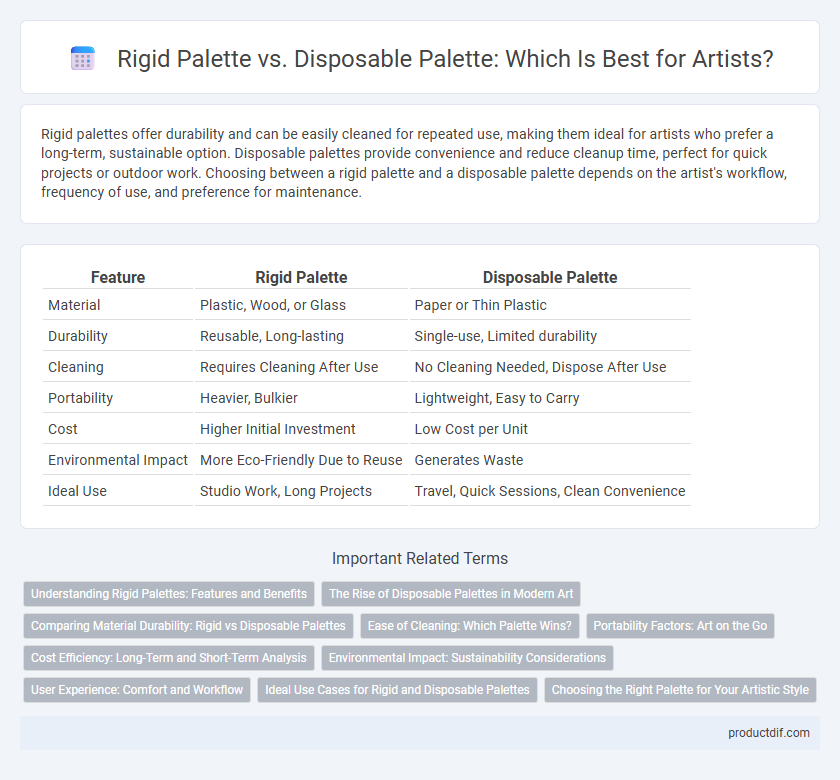Rigid palettes offer durability and can be easily cleaned for repeated use, making them ideal for artists who prefer a long-term, sustainable option. Disposable palettes provide convenience and reduce cleanup time, perfect for quick projects or outdoor work. Choosing between a rigid palette and a disposable palette depends on the artist's workflow, frequency of use, and preference for maintenance.
Table of Comparison
| Feature | Rigid Palette | Disposable Palette |
|---|---|---|
| Material | Plastic, Wood, or Glass | Paper or Thin Plastic |
| Durability | Reusable, Long-lasting | Single-use, Limited durability |
| Cleaning | Requires Cleaning After Use | No Cleaning Needed, Dispose After Use |
| Portability | Heavier, Bulkier | Lightweight, Easy to Carry |
| Cost | Higher Initial Investment | Low Cost per Unit |
| Environmental Impact | More Eco-Friendly Due to Reuse | Generates Waste |
| Ideal Use | Studio Work, Long Projects | Travel, Quick Sessions, Clean Convenience |
Understanding Rigid Palettes: Features and Benefits
Rigid palettes, typically made from wood, plastic, or metal, offer a durable and stable mixing surface ideal for artists seeking consistency in color blending and paint management. Their non-porous design prevents paint absorption, ensuring easier cleaning and longer usability compared to disposable palettes. The solid construction also supports portability and can accommodate various paint mediums without warping or degradation.
The Rise of Disposable Palettes in Modern Art
Disposable palettes have gained significant popularity among modern artists for their convenience and cost-effectiveness, offering a hygienic alternative to traditional rigid palettes. These palettes eliminate the need for tedious cleaning, enabling artists to maintain efficiency during fast-paced creative processes. The growing availability of eco-friendly materials in disposable options also aligns with the increasing demand for sustainable art supplies.
Comparing Material Durability: Rigid vs Disposable Palettes
Rigid palettes, typically made from durable materials such as wood, plastic, or glass, offer long-lasting resistance to scratches and stains, making them ideal for repeated use in mixing paints. Disposable palettes, usually constructed from lightweight paper or thin plastic, provide convenience with easy cleanup but lack durability, often warping or absorbing moisture during painting sessions. Artists prioritizing material longevity and consistent surface performance tend to prefer rigid palettes for their sturdiness and reliability in handling various mediums.
Ease of Cleaning: Which Palette Wins?
Rigid palettes offer a significant advantage in ease of cleaning due to their durable surfaces, typically made from materials like plastic, glass, or metal, which resist staining and allow for quick removal of dried paint. Disposable palettes eliminate cleaning time entirely by allowing artists to simply discard the used palette after a session, making them ideal for convenience but less sustainable. When prioritizing ease of cleaning, disposable palettes win for quick turnover, while rigid palettes provide long-term usability with straightforward maintenance.
Portability Factors: Art on the Go
Rigid palettes offer durable surfaces ideal for mixing paints thoroughly, but their bulk and weight can hinder portability for artists working on the go. Disposable palettes excel in portability, featuring lightweight, compact designs that are easy to carry and dispose of after use, making them perfect for outdoor or travel painting. The choice hinges on balancing the need for a stable mixing surface with the convenience of minimal cleanup and transport ease in mobile art settings.
Cost Efficiency: Long-Term and Short-Term Analysis
Rigid palettes offer greater long-term cost efficiency due to their durability and reusability, reducing the need for frequent replacements. Disposable palettes provide short-term savings with low upfront costs but incur continual expenses as they must be replenished regularly. Artists seeking a sustainable and economical option often favor rigid palettes for extended projects and repeated use.
Environmental Impact: Sustainability Considerations
Rigid palettes offer long-term use and reduce waste by eliminating the need for frequent replacement, making them a more sustainable choice for artists. Disposable palettes, often made from plastic or coated paper, contribute to landfill accumulation and require constant repurchasing, increasing environmental impact. Choosing a rigid palette supports eco-friendly practices by minimizing resource consumption and plastic pollution in art studios.
User Experience: Comfort and Workflow
Rigid palettes offer artists a stable, durable surface that enhances comfort by preventing slipping and providing ample space for color mixing, which streamlines workflow during extended painting sessions. Disposable palettes eliminate the need for cleanup, accelerating workflow and reducing downtime, but may lack the ergonomic support and surface stability found in rigid options. Choosing between them depends on the artist's preference for convenience versus tactile control and workspace consistency.
Ideal Use Cases for Rigid and Disposable Palettes
Rigid palettes are ideal for artists working with oil or acrylic paints who require a durable, easy-to-clean surface for mixing colors over multiple sessions. Disposable palettes suit watercolor artists or those working with gouache who prefer a convenient, single-use option to avoid cleanup and contamination. Both palette types support different workflows, with rigid palettes enhancing consistency in color mixing and disposable palettes offering portability and quick maintenance.
Choosing the Right Palette for Your Artistic Style
Selecting the ideal palette for your artistic style hinges on balancing durability and convenience. Rigid palettes, often made from wood or plastic, offer a sturdy mixing surface ideal for detailed color blending and long-term use. Disposable palettes, typically paper or plastic sheets, provide quick cleanup and portability, perfect for artists who prioritize efficiency and spontaneity in their practice.
Rigid Palette vs Disposable Palette Infographic

 productdif.com
productdif.com